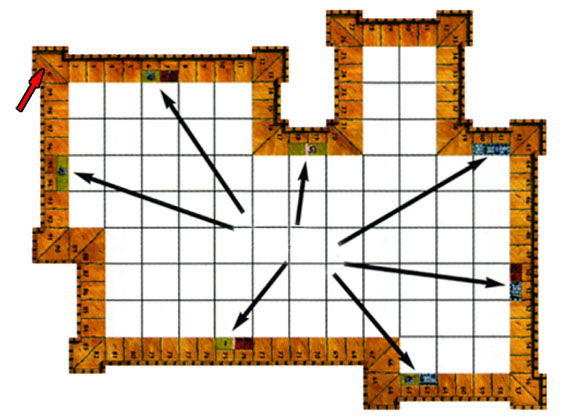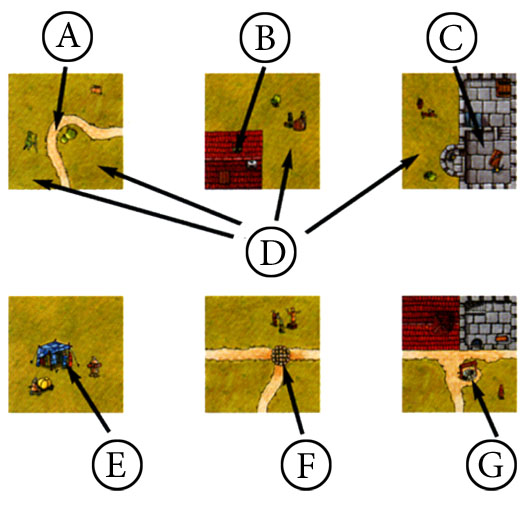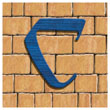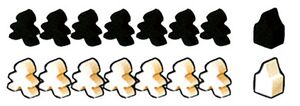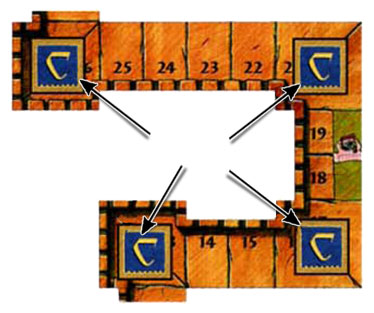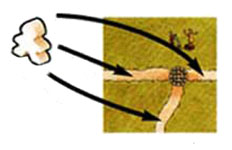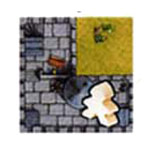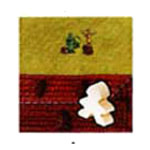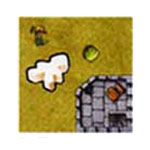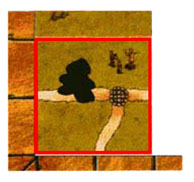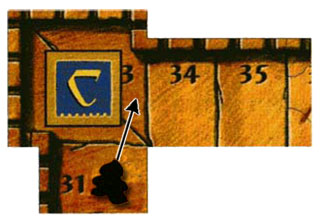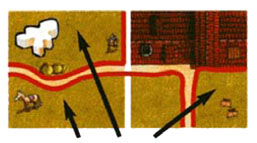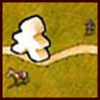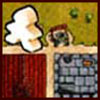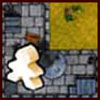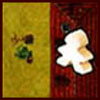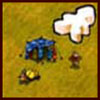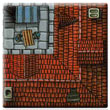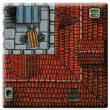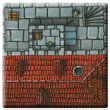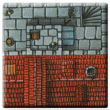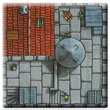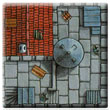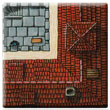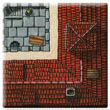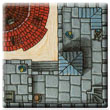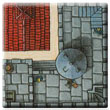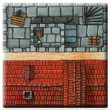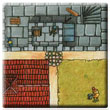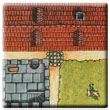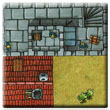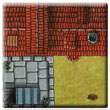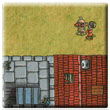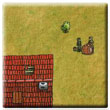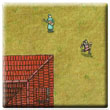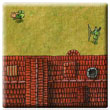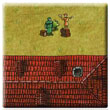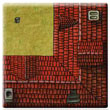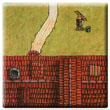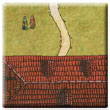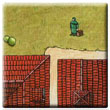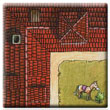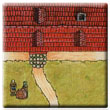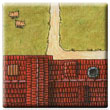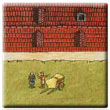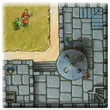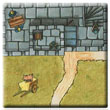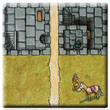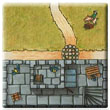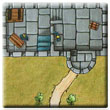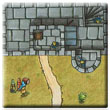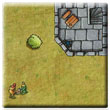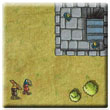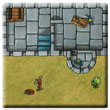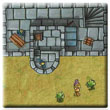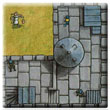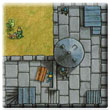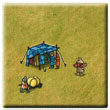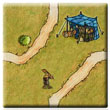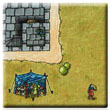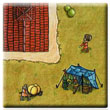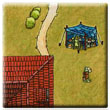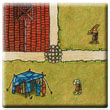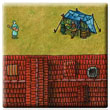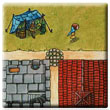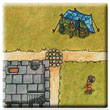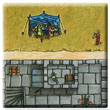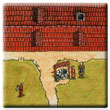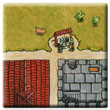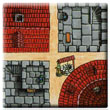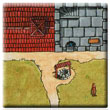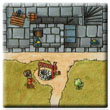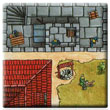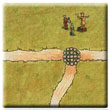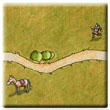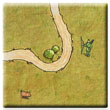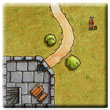Castelul: Jocul de bază
 |
Citești regulile pentru acest design al cartonașelor. |  |
| Dacă cartonașele arată astfel, atunci ai cartonașe de Carcassonne obișnuit. |  |
| Dacă cartonașele tale au un design diferit, atunci alege un joc din Spin-off-uri. |  |
Informații generale și comentarii
Lansat original de Hans im Glück în 2003, Carcassonne: Castelul este un joc entuziasmant de plasare a cartonașelor pentru 2 jucători, cu vârste de 8 ani în sus. Proiectat de Reiner Knizia, este bazat pe sistemul de joc al jocului Carcassonne de la Klaus Jürgen Wrede.
Silueta impozantă a orașului Carcassonne zace ca un tron în lumina soarelui apunând. Cavaleri păzesc turnuri, scutierii trăiesc în case, negustorii își laudă mărfurile în gura mare, iar vestitorii poartă veștile de-a lungul orașului. Dincolo de toată această forfotă, castelul se zărește în spatele zidurilor sale impenetrabile.
Conținut
- 1 zid de castel dîn 10 piese pe care jucătorii îl asamblează precum un puzzle înaintea fiecărei partide
- 60 de cartonașe de castel
- 18 cartonașe de zid (ilustrate câte două din fiecare cartonaș)
- 14 supuși în 2 culori și 2 donjoane în 2 culori
Obiectivul
Tură după tură, jucătorii plasează cartonașe de castel în cadrul zidurilor castelului. Astfel, acestea creează căi, turnuri, case și curți, pe care își plasează supușii pentru a încasa puncte. Jucătorii încasează puncte în timpul, și la sfârșitul, jocului. Jucătorul cu cele mai multe puncte la sfârșit este câștigătorul!
Pregătire
Asamblează zidul castelului, piesă cu piesă, astfel încât numerele de-a lungul părții de sus a zidului se desfășoară de la 0 până la 99.
Amestecă cele 60 de cartonașe de castel[1] cu fața în jos și plasează-le în stive în afara zidurilor castelului pe masă la îndemâna tuturor jucătorilor.
Amestecă cele 18 cartonașe de zid cu fața în jos. Plasează 1 cartonaș de zid cu fața în jos (fără a te uita la el) pe fiecare spațiu cu turn din colț de p4e zidul castelului (cu excepția turnului din colț cu „0/1”). Plasează cartonașele de zid nefolosite cu fața în jos fără a te uita la ele. Nu vor fi folosite în joc.
Fiecare jucător alege o culoare și ia cei 7 supuși și donjon în acea culoare și plasează 1 supus drept marcator de scor pe spațiul 0 al traseului de punctaj. Fiecare jucător își pune supușii rămași și donjonul în zona lor de joc (zona de pe masă din fața lor). Jucătorii decid între ei cine va începe jocul.
Desfășurarea jocului
Jucătorii efectuează ture în mod alternativ începând cu jucătorul de pornire. În tura unui jucător, acesta efectuează următoarele acțiuni în ordinea arătată mai jos:
- Jucătorul trebuie să tragă un cartonaș de castel dintr-una dintre stivele cu fața în jos și să îl plaseze în cadrul castelului.
- Jucătorul are posibilitatea de a plasa unul singur dintre supușii din rezerva sa pe cartonașul tocmai plasat.
- Dacă, cu plasarea cartonașului, jucătorul a finalizat o cale, un turn și/sau o casă, jucătorii trebuie să evalueze acum teritoriul finalizat.
- Atunci când un jucător, după evaluare, și-a mutat marcatorul de scor pe un spațiu cu turn din colț de pe zidul castelului, ia imediat cartonașul de zid de pe acel spațiu, dacă încă se află acolo.
Trage și plasează un cartonaș de castel
Ca prima acțiune a turei unui jucător, jucătorul trebuie să tragă un cartonaș de castel dintr-unul dintre stivele cu fața în jos. Jucătorul ar trebui să îl arate adversarului său (care poate oferi sfaturi pentru plasare) punându-l cu fața în sus în zona sa de joc. Apoi, jucătorul trebuie să facă următoarele:
- Primul cartonaș de castel plasat în joc trebuie plasat cu o latură plasată complet lângă oricare dintre cele șapte spații de start de-a lungul zidului castelului.
- Fiecare cartonaș ulterior plasat (arătate în exemple cu un chenar roșu) trebuie plasat cu o latură complet lângă un spațiu de start de-a lungul zidului castelului sau cu cel puțin o latură complet lângă un cartonaș plasat anterior. Plasarea unui cartonaș colț la colț sau jumătate de cartonaș pe jumătate de cartonaș nu este permis.
- Căile trebuie mereu continuate atunci când ating marginea unui cartonaș[2]. Celelalte teritorii de castel (turn, casă sau curte) pot fi plasate unul lângă celălalt în orice combinație dorită.
- Orice teritoriu de castel (cale, turn, casă sau curte) poate să fie plasat lângă zidul castelului.
- Dacă nu există niciun loc legal pentru un cartonaș tras (și ambii jucători sunt de acord) cartonașul este plasat în cutie (afară din joc) și jucătorul trage un nou cartonaș pe care să îl plaseze.
Place a follower
After placing a castle tile, the player may place one of their followers. To do so :-
- a player may only place 1 follower per turn
- the player must take the follower from their supply
- the player may only place the follower on the tile just placed
- the player must choose which feature of the castle tile to place the follower on - either as a ...
| or as a | or as a | or as a | ||||
| Herald on a path | Knight on a tower | Squire on a house | Merchant on a court (with or without market) |
- each new castle tile can enlarge an already existing path, tower, house or court. If there is already a follower (even the player's own) on the enlarged castle feature, the player may not place a follower on that feature. It matters not how far away the other follower is. Below are examples of allowed and disallowed follower placement :-
It is possible in the course of the game, however, for there to be more than one squire on a house, more than one knight on a tower, more than one herald on a path, and more than one merchant on a court. See Connecting paths, towers, houses and courts.
If a player has no followers in their supply, the player may not place one. However, players get their followers back during the game when features are completed and scored.
If the player did not complete a path, tower, or house, the player's turn is over and the opponent takes their turn.
Scoring completed paths, towers and houses
If, by placing the castle tile, the player completed a path, tower or house, the players now score the completed feature(s). Courts are not scored during the game - they are scored at the end of the game.
A completed path
A path is complete when the connected path segments [3] end in squares, the castle walls, buildings [4], or when the path becomes a closed loop. There is no limit to the length of a path; it can wander across many castle tiles and can branch and so have more than two ends.
The player with the most heralds on the completed path scores points for the path. The player scores 1 point for each castle tile (not each path segment) that is on the path. If the path includes a path segment on a start space, this counts as 1 point as though it were a castle tile.
The player moves their scoring marker along the castle wall scoring track to record the points scored. The scoring track runs around the castle walls for 100 spaces. When a player moves their scoring marker past space 99, the player continues to space 0, laying the scoring marker on its side to note that it has passed 100 points.
If there are one or more fountains along the completed path, the player scores 2 points for each castle tile on the completed path. Even if a path has several fountains, it still scores 2 points for each castle tile.
A completed tower
A tower is complete when the connected tower segments are completely surrounded by paths, houses, courts, and the castle wall (and the tower contains no empty spaces). There is no limit to the size of a tower. It can consist of many castle tiles.
The player with the most knights on the completed tower scores points for the tower. The player scores 2 points for each castle tile (not each segment) that forms the tower. If the tower includes a tower segment on a start space, this counts 2 points as though it were a castle tile.
A completed house and the keep
A house is complete when the connected house segments are completely surrounded by paths, towers, courts and the castle wall (and the house contains no empty spaces). There is no limit to the size of a house. It can consist of many castle tiles.
The player with the most squires on a completed house scores points for the house. The players scores 1 point for each castle tile (not each house segment that forms the house). If the house includes a house segment on a start space, this counts 1 point as though it were a castle tile.
When a player scores their first house, the player places their keep on it. If, later in the game, the player scores a larger house (the player has the most squires on a completed house) than the one on which the player's keep stands, the player moves their keep to the larger house. Thus, at the end of the game, each player's keep marks the largest house that they have completed.
Connecting paths, towers, houses and courts
By placing castle tiles, players may connect separate features that have followers on them.
By connecting such features, players can create
- a path with more than one herald
- a tower with more than one knight
- a house with more than one squire, or
- a court with more than one merchant
When scoring a completed path, tower, or house, the players first check to see if one player has more followers on the completed features than the other. If so, this player scores all the points for the feature alone. If both players have the same number of followers on the completed feature, neither scores the points for the completed feature.

Note: having several followers on a feature as described above does not contradict the rule "If there is already a follower (even the player's own) on the enlarged feature, the player may not place a follower on that feature". This rule is for the placing of followers! In the case above, features with followers that were originally placed on separated features are now connected. Thus, after the connection, the followers are on the same feature. Players may even plan their moves with future connections in mind.
The return of followers to their owners
After a path, tower, or house is completed and scored - and only then - the players take back their followers from the feature scored, putting them in their supplies. The followers are returned to the player's supply at the end of the turn. Thus they are available on the player's next turn and may be used in any role.
It is possible in a single turn for a player to place a follower, score the feature it is on, and take back the follower into their supply. To do this, a player must (always in this order) :-
- Place a new castle tile, completing a path, tower or house
- Place a follower on the completed path, tower or house
- Score the completed path, tower or house
- Take back the follower from the scored path, tower or house
The wall tiles
When, as a result of scoring, a player moves their scoring marker to either of the two spaces on a corner tower of the castle wall scoring track, the player takes the wall tile lying there (if it is still there) and places it face up in their play area. When a player moves their scoring marker past the corner, the player does not take a wall tile as they pass [5].
A player may use a wall tile, taken in this turn, on the next turn or any later turn, depending on which tile it is. On their turn [6], a player may use one or more wall tiles. Once played, a wall tile is removed from the game. For a complete description of the wall tiles, see the later section Description of Wall Tiles.
When taking a wall tile, the following is important: When the placement of a castle tile results in more than one completed feature, the player placing the tile scores their completed features first. If there is more than one feature to score for the player or their opponent, the placing player decides the order. [7]
The court
Courts are separated from each other by paths, towers and houses. When a player places a merchant on a court, it is placed on its side to emphasize that it cannot be returned to the player during the game. Courts are only scored at the end of the game.
End of a player's turn
After scoring and taking appropriate wall tiles from the scoring track, the player's turn is over, and their opponent then takes their turn.
Game End
The game ends at the end of the turn when the last castle tile is placed.
Remove all remaining wall tiles from the castle wall and then perform the final scoring.
Final scoring (scoring the keep, courts and wall tiles)
During final scoring, the players score the largest keep and the courts.
Also, the players can now use wall tiles 4 through 9. Incomplete paths, towers and houses are not scored! Exception: players who have wall tiles 4, 5 or 6.
Scoring the largest keep
The player with the largest keep (the player with the largest completed house [8]) scores the following points.
There will be at least 16 empty spaces within the castle walls at the end of the game. The players determine which connected area of empty spaces is the largest and count the number of castle tiles that would fit in this area [9]. The player with the largest keep scores this number of points by moving their scoring marker on the scoring track. If both players tie for the largest keep, neither scores for it. Note: wall tile 8!
Scoring the courts
The player with the most merchants on a court space [10] scores 3 points for each market on the court. If both players have the same number of merchants on a court, neither scores points for the court.
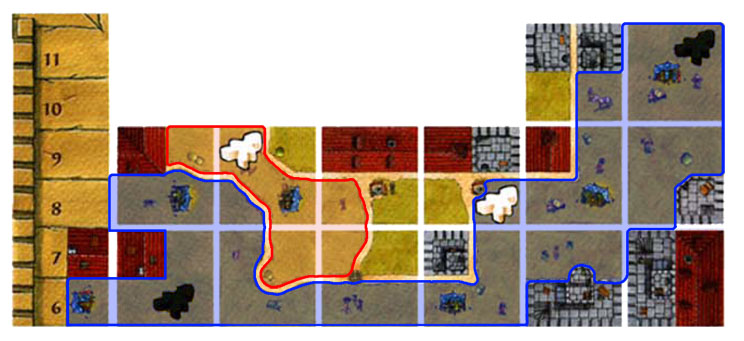
There are 5 markets on the large court, including the one on the start space next to the castle wall. Black has the most merchants on the large court. Black scores 15 points and moves their scoring marker on the scoring track. White scores nothing for this court. If black has wall tile 7, each market on the court would be worth 4 points for a total of 20 points.
Finally, players score points for wall tiles 4, 5, 6 (for incomplete features), and 9, if they have them.
The player with the most points is the winner.
Description of wall tiles
1 
|
The player takes another complete turn (during the game) [11] | 6 
|
The player scores 1 point per tile for 1 incomplete house (at game end) |
2 
|
The player doubles the score of 1 completed tower when scoring it (each tile = 4 points) [12] | 7 
|
The player scores 4 points for each market on 1 court (at game end) |
3 
|
The player doubles the score of 1 completed house when scoring it (each tile = 2 points) [13] | 8 
|
The player enlarges their keep by 2 tiles (at game end). For example, a keep of 5 tiles is counted as a keep of 7 tiles |
4 
|
The player scores 1 point per tile (2 with a fountain [14]) for 1 incomplete path (at game end) | 9 
|
The player scores 5 points (at game end) |
5 
|
The player scores 2 points per tile for 1 incomplete tower (at game end) | ||
| Tiles 1-3 are played during the game.
Tiles 4-9 are played at the end of the game. To play wall tiles 2-7, the player must have more followers on the feature than their opponent. Designer's clarifications for when an individual player holds both of a specific wall tile: [15]
| |||
Rezumat de evaluare
| Tabelul punctelor | ||||
| cale | cale (cu fântână) |
turn | casă | piață |
| 1 | 2 | 2 | 1 | 3 |
Reguli ale casei
- Colectarea cartonașelor de zid: Poți ridica un cartonaș de zid numai dacă aterizezi pe spațiul din colț la sfârșitul tuturor mișcărilor de evaluare ale acelei ture.
Ansamblul cartonașelor
Cartonașe obișnuite totale: 60
Cartonașe de zid totale: 18
Note de subsol
Pentru licențierea și semnificația pictogramelor te rugăm să vizitezi Pagina pictogramelor.
- ↑
 Termenul „cartonașe de castel” se referă la toate cartonașele plasate în cadrul zidurilor castelului în timpul jocului.
Termenul „cartonașe de castel” se referă la toate cartonașele plasate în cadrul zidurilor castelului în timpul jocului.
- ↑
 Atunci când sunt plasate împreună unele combinații de cartonașe cu căi, drumurile nu se conectează. Acest lucru este doar pentru că stilul grafic/tipărirea este ușor deplasată și nu pentru că căile se sfârșesc.
Atunci când sunt plasate împreună unele combinații de cartonașe cu căi, drumurile nu se conectează. Acest lucru este doar pentru că stilul grafic/tipărirea este ușor deplasată și nu pentru că căile se sfârșesc.
- ↑
 Points are scored only when ALL branches of a path have an end. Some paths can get pretty long, with multiple branches, in this game.
Points are scored only when ALL branches of a path have an end. Some paths can get pretty long, with multiple branches, in this game.
- ↑
 Paths must only connect to paths (or castle walls). You may not block off a path using a house, or tower, tile edge.
Paths must only connect to paths (or castle walls). You may not block off a path using a house, or tower, tile edge.
- ↑
 If you score 100 points before the game ends, passing 0 on the scoretrack, and then land on a missed wall tile from the first time round, you can you still pick it up.
If you score 100 points before the game ends, passing 0 on the scoretrack, and then land on a missed wall tile from the first time round, you can you still pick it up.
- ↑
 You may not play them during your opponent's turn, even though your opponent completes a feature for which you score.
You may not play them during your opponent's turn, even though your opponent completes a feature for which you score.
- ↑
 Each feature is scored separately, so the order in which they are scored can be important if it is possible to land on a tower segment with a wall tile with the first.
Each feature is scored separately, so the order in which they are scored can be important if it is possible to land on a tower segment with a wall tile with the first.
- ↑
 The rules don't say what "largest" means. Since all scoring is by tile, it is probably safe to assume that it is by the number of tiles, rather than the overall footprint (as measured in the number of quarter tiles).
The rules don't say what "largest" means. Since all scoring is by tile, it is probably safe to assume that it is by the number of tiles, rather than the overall footprint (as measured in the number of quarter tiles).
- ↑
 Castle wall start spaces, that have not had tiles placed against them, may be included when counting up the size of your keep.
Castle wall start spaces, that have not had tiles placed against them, may be included when counting up the size of your keep.
- ↑
 The boundary of each court is whatever it is surrounded by at this time: paths, towers, houses, castle walls, and the edge of the tile.
The boundary of each court is whatever it is surrounded by at this time: paths, towers, houses, castle walls, and the edge of the tile.
- ↑
 It is normal to play it during the turn you win it (after you remove and score the meeple that won it). You simply take another turn before your opponent gets their turn. But there is nothing to stop you saving it to use later. You could even have two bonus turns at the same time if you are lucky enough to get them both.
It is normal to play it during the turn you win it (after you remove and score the meeple that won it). You simply take another turn before your opponent gets their turn. But there is nothing to stop you saving it to use later. You could even have two bonus turns at the same time if you are lucky enough to get them both.
- ↑
 If you collect this tile when scoring a tower you may not use it immediately to boost the score of that tower. It must be used on a later turn.
If you collect this tile when scoring a tower you may not use it immediately to boost the score of that tower. It must be used on a later turn.
- ↑
 If you collect this tile when scoring a house you may not use it immediately to boost the score of that house. It must be used on a later turn.
If you collect this tile when scoring a house you may not use it immediately to boost the score of that house. It must be used on a later turn.
- ↑
 Scoring 2 points for an incomplete path was only introduced in the RGG version of the English rules. In the original German rules, and others including the 2020 Polish Zamek release, an incomplete path or road is worth 1 point per tile (whether it has a fountain on it, or not). This has also been confirmed by the designer.
Scoring 2 points for an incomplete path was only introduced in the RGG version of the English rules. In the original German rules, and others including the 2020 Polish Zamek release, an incomplete path or road is worth 1 point per tile (whether it has a fountain on it, or not). This has also been confirmed by the designer.
- ↑
 Source: Third hand via BGG
Source: Third hand via BGG

